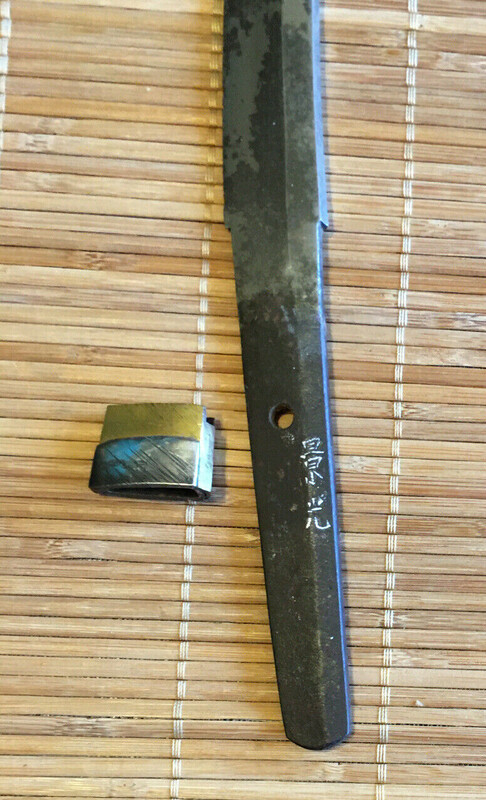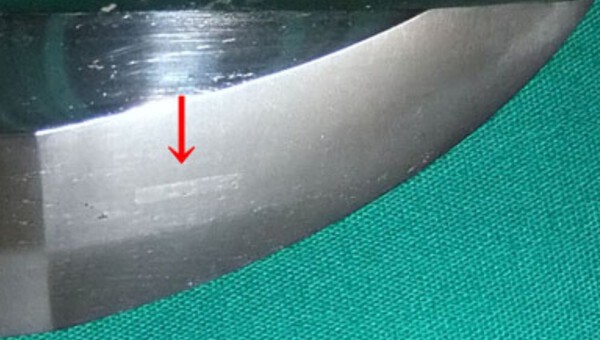-
Posts
215 -
Joined
-
Last visited
-
Days Won
1
Content Type
Profiles
Forums
Events
Store
Downloads
Gallery
Everything posted by JH Lee
-
Thank you. As I said, I also do NOT believe this is the renowned Osafune Kagemitsu. The mei does not match, and, as you have said, the shape is wrong for the period. Were there many other smiths who signed their work "Kagemitsu"? Does anyone recognize this particular signature?
-
So, probably not the renowned Osafune Kagemitsu. Please see below. Also, an additional question about wakizashi size. How common was it for a shinogi-zukuri wakizashi to be made intentionally slender in profile? For example, ~2.5cm at the motohaba and <1.7cm at the sakihaba? I understand many surviving nihonto are not what they were when they were newly made, due to repolishing and so on. I am just wondering about the worthiness of a bladed weapon whose cutting edge is so slender. There just doesn't seem to be enough mass for many of the koryu kata I've seen that involve deflection and parry, never mind a deep enough cut (through clothing and into meat, potentially hitting bone, etc.) to deal significant damage to an opponent. Of course, I have read in some of the older threads here on NMB that certain fencing schools preferred slender profiles, and that upper echelon nobles may have wanted more slender and elegant blades as well.
-

Thoughts on ww2 Japanese double knife set
JH Lee replied to samurai1's topic in Auctions and Online Sales or Sellers
Looks like someone got a very nice deal! -
🤷🏻♂️
-
It's Chris Osborne's new shop. https://www.facebook.com/christopher.osborne.12532
-

Thoughts on this Octopus Tsuba ...
JH Lee replied to TheGermanBastard's topic in Auctions and Online Sales or Sellers
I admire the skill and artistry. Also, I now want seafood for dinner. -
David Hofhine. Josiah Boomershine.
-
I thought it was tonbo at first too, but look closely at where the head should be. Those look like flower parts and not a dragonfly head.
-
Flower. Makie?
-
To each their own~ I personally really like the 2nd gen Kinmichi. Also, the fact that we both have papered blades attributed to the same smith with clear stylistic similarities leads me to think they are therefore shoshin. At least, it reassures me that the shinsa experts are doing their best to apply their knowledge and criteria with consistency and reliability. 🤷🏻♂️
-
BREATHTAKING 🤯🤯🤯
-
I tend to agree with you. Also, I would assume that a gimei with a "big" name would need to have been made relatively well (at least above average?) if it would have hope of fooling a buyer. But that's just conjecture on my part.
-
Sometimes I wonder if at least some gimei were done as a token of admiration/flattery and not strictly to fool a buyer.... 🤷🏻♂️ Personally, I'd rather have a mumei than gimei, all other things being equal. But either way, I will prioritize quality/state of preservation over the mei in decisions about what I want to buy/collect.
-

Is there any way to fix a hagire?
JH Lee replied to Novalame's topic in General Nihonto Related Discussion
-
Thank you so much! A HUGE fan of your work, by the way. I've watched all of your YouTube videos with wonder....
-
Thank you. Was this the traditional method? I'm just wondering how they precision soldered without modern electric soldering tools, including masking without adhesive tape. It's pretty impressive they were able to achieve such nice and even rust patina on the iron surface -- which I think usually involves some heat to speed the reaction -- without undermining the integrity of the soldered parts.
-
Me? or Chris? Mine is papered. I'm sure his would get papers if not already... the mei with kiku mon look legit to me (though I'm still just a beginner; so grains of salt all around).
-

Is there any way to fix a hagire?
JH Lee replied to Novalame's topic in General Nihonto Related Discussion
Oh, yikes. No, there's no way to fix that except maybe cosmetically with a "patch" blended in. But its life as a serviceable weapon is over, unless it is shortened o-suriage. -
-
Good advice. However, it is not feasible for me to join a nihonto club (nearest one to me is a 2.5 hr drive; yes, I already looked), especially with a full work schedule and a toddler. Best I can manage at the moment is the occasional forum and google browsing during breaks. I'm not planning on any major purchases at the moment. Though, if I had the funds to spare, I would gladly jump on that mantetsu in the for sale section.
-
Ok, fair enough. I am in total agreement with both Ken and Chris about how the togishi should not remove any more metal than is necessary and only attempt restoration work with sufficient knowledge, training, skill, etc. Beyond that, I do not know enough to agree or disagree about David Hofhine's abilities, except to say that the photos on his site look pretty amazing to me personally (and apparently, to numerous other clients,as well). As for the particular sword in these photos, it would seem that he just re-finished the surface appearance without altering the actual shape/geometry. And while all polishing removes some material regardless, I would assume that whatever amount is removed by fingerstones is probably only measurable in microns, if that. Anyway, not what this thread was about. Since I seem to have chosen photos not high-resolution enough for an interesting and informative conversation about kantei, I will keep googling and try to chip away at the helpful resources like the Markus Sesko link. Thanks for your input.
-
I thought that the entire blade was visible in the bottom-most picture. Perhaps it was not high resolution enough. What do you see that is less than ideal about the new polish above? To my eyes, I thought everything looked a lot more crisp and attractive after the new polish, and more details of the hamon was also revealed. Maybe a higher resolution photo under different lighting would have shown the hada better as well....
-
Well, I guess we'll just have to chalk this one up to my not quite knowing what to look for yet. Wish there were other photos of this sword but these were the only ones on the site. Oh well!
-
I chose this picture from the internet bc I thought it was a good candidate. It shows close up and overall picture of a blade in fresh new polish (you can zoom in if you click on the image). The kesho/hadori is not overdone or so thick as to obscure the details of the hamon. So, I figured pictures of this mumei sword would allow the more experienced collectors here to make good assessments. What would need to be more visible? [Edit] Actually, now that I'm looking at the zoomed image, the hada is not clearly visible. The image is not high resolution enough and not the right lighting for that. But do the sugata, shape of nakago, and style of hamon reveal anything?
-
Anyone else with thoughts about this sword and its origins? I'm just interested to hear the thinking process, how and why you're applying certain specific criteria and knowledge in your assessment. I figured it's probably the best way for me to learn (through such examples), rather than flailing wildly in a sea of information and getting things completely wrong without improvement.









